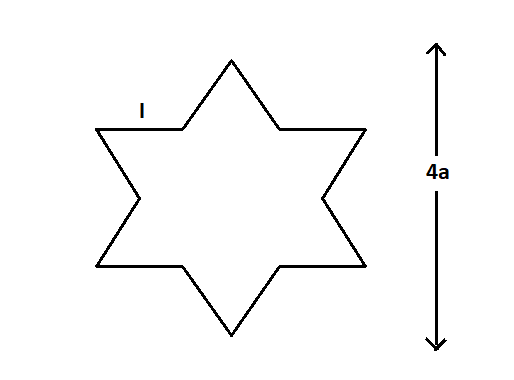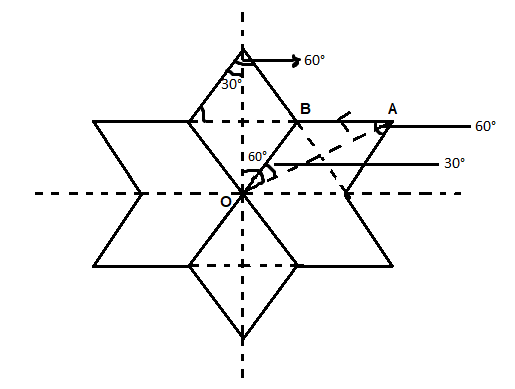
A symmetric star conducting wire loop is carrying a steady current

(A)
(B)
(C)
(D)
Answer
142.8k+ views
Hint We have a conductor in the shape of a symmetric star. The current
Complete step by step answer:
According to the right-hand thumb rule, the magnetic field due to the star-shaped current-carrying conductor will be in the upward direction. Since there are

Let us consider any one of the sides as

The field at a point
The dotted lines show the normal perpendicular to the point
The general formula for the field at the point
From the above two diagrams, we get
Where
Let us assume that the field due to the side
The field
We know that
Substituting the value, we get
This is the magnetic field due to one side of the star.
We know that the total magnetic field at the center of the star will be
Therefore, we can write the total magnetic field at the center of the star will be,
This will be,
The answer is: Option (A):
Note
The strength of the magnetic field will be directly proportional to the current through the conductor. The magnetic field will also depend on the length of the conductor that we consider. It is also proportional to the sine angle between the element in the direction of current and the line joining the element and the point of consideration. The magnetic field is inversely proportional to the distance between the conductor and the point of consideration.
Complete step by step answer:
According to the right-hand thumb rule, the magnetic field due to the star-shaped current-carrying conductor will be in the upward direction. Since there are

Let us consider any one of the sides as

The field at a point
The dotted lines show the normal perpendicular to the point
The general formula for the field at the point
From the above two diagrams, we get
Where
Let us assume that the field due to the side
The field
We know that
Substituting the value, we get
This is the magnetic field due to one side of the star.
We know that the total magnetic field at the center of the star will be
Therefore, we can write the total magnetic field at the center of the star will be,
This will be,
The answer is: Option (A):
Note
The strength of the magnetic field will be directly proportional to the current through the conductor. The magnetic field will also depend on the length of the conductor that we consider. It is also proportional to the sine angle between the element in the direction of current and the line joining the element and the point of consideration. The magnetic field is inversely proportional to the distance between the conductor and the point of consideration.
Latest Vedantu courses for you
Grade 10 | MAHARASHTRABOARD | SCHOOL | English
Vedantu 10 Maharashtra Pro Lite (2025-26)
School Full course for MAHARASHTRABOARD students
₹33,300 per year
EMI starts from ₹2,775 per month
Recently Updated Pages
How to find Oxidation Number - Important Concepts for JEE

How Electromagnetic Waves are Formed - Important Concepts for JEE

Electrical Resistance - Important Concepts and Tips for JEE

Average Atomic Mass - Important Concepts and Tips for JEE

Chemical Equation - Important Concepts and Tips for JEE

Concept of CP and CV of Gas - Important Concepts and Tips for JEE

Trending doubts
JEE Main 2025 Session 2: Application Form (Out), Exam Dates (Released), Eligibility, & More

JEE Main Exam Marking Scheme: Detailed Breakdown of Marks and Negative Marking

JEE Main 2025: Derivation of Equation of Trajectory in Physics

Electric Field Due to Uniformly Charged Ring for JEE Main 2025 - Formula and Derivation

Electric field due to uniformly charged sphere class 12 physics JEE_Main

Degree of Dissociation and Its Formula With Solved Example for JEE

Other Pages
JEE Advanced Marks vs Ranks 2025: Understanding Category-wise Qualifying Marks and Previous Year Cut-offs

JEE Advanced 2025: Dates, Registration, Syllabus, Eligibility Criteria and More

JEE Advanced Weightage 2025 Chapter-Wise for Physics, Maths and Chemistry

Dual Nature of Radiation and Matter Class 12 Notes: CBSE Physics Chapter 11

Formula for number of images formed by two plane mirrors class 12 physics JEE_Main

Electrical Field of Charged Spherical Shell - JEE




